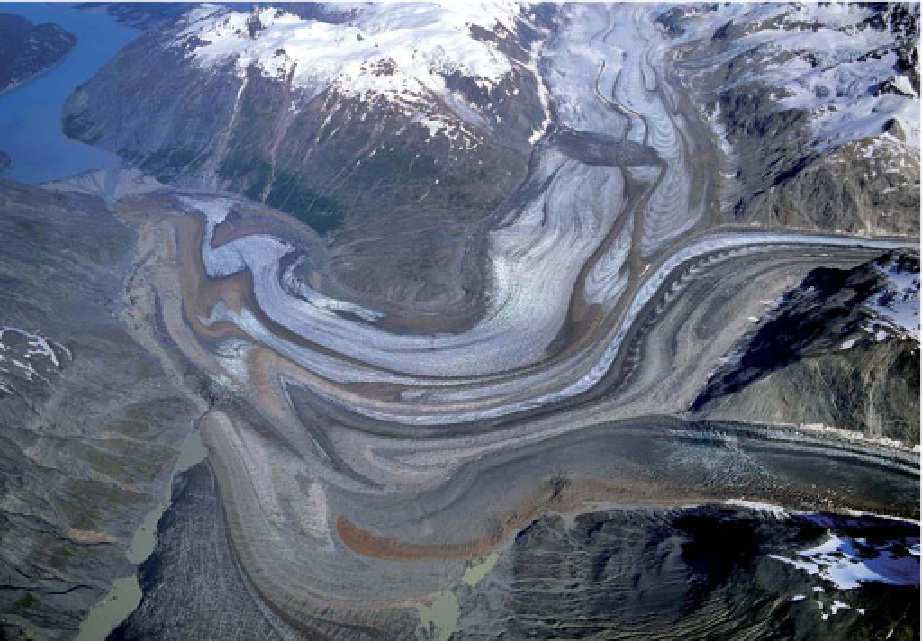Geology Reference
In-Depth Information
of how the shape changes required by
the buckle-folded layers are achieved
by displacements along small faults.
In deformation at lower crustal
levels, under conditions of elevated
temperature and pressure, rocks typi-
cally develop a
fabric
(
see
Chapter 7)
and tend to be dominated by similar-
style folding where the flow direction
is across the layers, which merely
rotate passively in response. Here the
whole rock is involved in the strain
due to pervasive recrystallisation; ulti-
mately, each individual grain or particle
may have changed shape in order to
accommodate to the overall strain.
It is difficult to imagine solid rock
behaving in this way, and because
the process is so slow, it cannot be
observed. Fortunately, however, flow
folds of broadly similar style can be
seen in glacier ice (Figure 6.8) which
does deform in the solid state and over
observable timescales. Such flow pat-
terns, therefore, are an exact analogy of
the type of folding seen in some meta-
morphic rocks (e.g.
see
Figure 7.5A).
buckled layers has to deform by a differ-
ent mechanism, such as lateral shear, or
flow, controlled by the stronger layers
on either side moving in opposite direc-
tions. However, a set of folded layers of
varying thickness and/or strength will
probably respond to buckling in differ-
ent ways, and the layers may then show
a variety of wavelengths, as in Figure
6.9B. If such a set of folded layers is
unravelled, the length of the unfolded
layers varies, despite the fact that the
amount of shortening applied to the set
as a whole would have been the same.
This, at first sight, paradoxical result is
explained by the fact that the thicker or
stronger layers experience some (layer-
parallel) shortening strain before buck-
ling is initiated, whereas the thinner
or weaker layers tend to buckle more
readily. The minimum amount of layer-
parallel shortening experienced by the
set of layers is given by the difference
between the longest and shortest unrav-
elled layers as shown in Figure 6.9B.
Figure 6.9C shows the end result
when a thin layer, having buckled
early in the shortening process, has
been subsequently refolded on a
longer wavelength controlled by the
two neighbouring thicker layers that
commenced buckling later. Fold sets
displaying markedly different wave-
lengths are common (e.g.
see
Figure
6.2A) and it will be seen from this
Multilayer buckle folding
In a set of layers dominated by buckle
folding, the wavelength of the individual
folded layers may be the same, as in
Figure 6.9A, which is the likely outcome
if the layers are all of approximately
equal thickness and are composed of
similar relatively strong material, such
as limestone or sandstone. In such a
case, the weaker material between the
Figure 6.8
Flow folds in glacier ice, Lewis glacier,
Alaska. The folds on the surface of the glacier
are formed by variously coloured layers of rock
debris and other structures such as crevasses,
originally oriented transversely, which have been
deformed by the solid flow of the glacier ice; the
direction of flow is parallel to the walls of the
glacier and is greater towards the centre. ©Jim
Wark.



Search WWH ::

Custom Search